3.3: Real Zeros of Polynomials
( \newcommand{\kernel}{\mathrm{null}\,}\)
In Section 3.2, we found that we can use synthetic division to determine if a given real number is a zero of a polynomial function. This section presents results which will help us determine good candidates to test using synthetic division. There are two approaches to the topic of finding the real zeros of a polynomial. The first approach (which is gaining popularity) is to use a little bit of Mathematics followed by a good use of technology like graphing calculators. The second approach (for purists) makes good use of mathematical machinery (theorems) only. For completeness, we include the two approaches but in separate subsections. Both approaches benefit from the following two theorems, the first of which is due to the famous mathematician Augustin Cauchy. It gives us an interval on which all of the real zeros of a polynomial can be found.
Theorem 3.8: Cauchy's Bound
Suppose
f(x)=anxn+an−1xn−1+…+a1x+a0
is a polynomial of degree n with n≥1. Let M be the largest of the numbers:
|a0||an|,|a1||an|,…,|an−1||an|
Then all the real zeros of f lie in in the interval [−(M+1),M+1].
The proof of this fact is not easily explained within the confines of this text. Like many of the results in this section, Cauchy's Bound is best understood with an example.
Example 3.3.1:
Let f(x)=2x4+4x3−x2−6x−3. Determine an interval which contains all of the real zeros of f.
Solution
To find the M stated in Cauchy's Bound, we take the absolute value of leading coefficient, in this case |2|=2 and divide it into the largest (in absolute value) of the remaining coefficients, in this case |−6|=6. We find M=3, so it is guaranteed that the real zeros of f all lie in [−4,4].
Whereas the previous result tells us where we can find the real zeros of a polynomial, the next theorem gives us a list of possible real zeros.
Theorem 3.9: Rational Zeros Theorem
Suppose f(x)=anxn+an−1xn−1+…+a1x+a0 is a polynomial of degree n with n≥1, and a0, a1, ... an are integers. If r is a rational zero of f, then r is of the form ±pq, where p is a factor of the constant term a0, and q is a factor of the leading coefficient an.
The Rational Zeros Theorem gives us a list of numbers to try in our synthetic division and that is a lot nicer than simply guessing. If none of the numbers in the list are zeros, then either the polynomial has no real zeros at all, or all of the real zeros are irrational numbers. To see why the Rational Zeros Theorem works, suppose c is a zero of f and c=pq in lowest terms. This means p and q have no common factors. Since f(c)=0, we have
an(pq)n+an−1(pq)n−1+…+a1(pq)+a0=0.
Multiplying both sides of this equation by qn, we clear the denominators to get
anpn+an−1pn−1q+…+a1pqn−1+a0qn=0
Rearranging this equation, we get
anpn=−an−1pn−1q−…−a1pqn−1−a0qn
Now, the left hand side is an integer multiple of p, and the right hand side is an integer multiple of q. (Can you see why?) This means anpn is both a multiple of p and a multiple of q. Since p and q have no common factors, an must be a multiple of q. If we rearrange the equation
anpn+an−1pn−1q+…+a1pqn−1+a0qn=0
as
a0qn=−anpn−an−1pn−1q−…−a1pqn−1
we can play the same game and conclude a0 is a multiple of p, and we have the result.
Example 3.3.2:
Let f(x)=2x4+4x3−x2−6x−3. Use the Rational Zeros Theorem to list all of the possible rational zeros of f.
Solution
To generate a complete list of rational zeros, we need to take each of the factors of constant term, a0=−3, and divide them by each of the factors of the leading coefficient a4=2. The factors of −3 are ±1 and ±3. Since the Rational Zeros Theorem tacks on a ± anyway, for the moment, we consider only the positive factors 1 and 3. The factors of 2 are 1 and 2, so the Rational Zeros Theorem gives the list {±11,±12,±31,±32} or {±12,±1,±32,±3}.
Our discussion now diverges between those who wish to use technology and those who do not.
For Those Wishing to use a Graphing Calculator
At this stage, we know not only the interval in which all of the zeros of f(x)=2x4+4x3−x2−6x−3 are located, but we also know some potential candidates. We can now use our calculator to help us determine all of the real zeros of f, as illustrated in the next example.
Example 3.3.3:
Let f(x)=2x4+4x3−x2−6x−3.
- Graph y=f(x) on the calculator using the interval obtained in Example 3.3.1 as a guide.
- Use the graph to shorten the list of possible rational zeros obtained in Example 3.3.2.
- Use synthetic division to find the real zeros of f, and state their multiplicities.
Solution
In Example 3.3.1, we determined all of the real zeros of f lie in the interval [−4,4]. We set our window accordingly and get
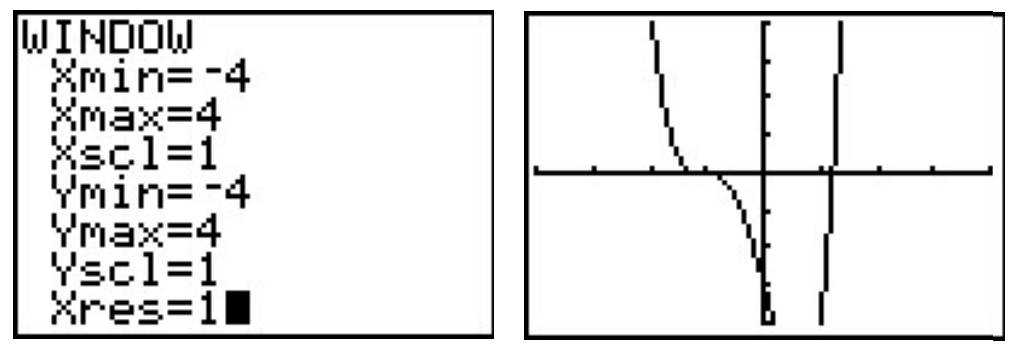
In Example 3.3.2, we learned that any rational zero of f must be in the list {±12,±1,±32,±3}. From the graph, it looks as if we can rule out any of the positive rational zeros, since the graph seems to cross the x-axis at a value just a little greater than 1. On the negative side, −1 looks good, so we try that for our synthetic division.

We have a winner! Remembering that f was a fourth degree polynomial, we know that our quotient is a third degree polynomial. If we can do one more successful division, we will have knocked the quotient down to a quadratic, and, if all else fails, we can use the quadratic formula to find the last two zeros. Since there seems to be no other rational zeros to try, we continue with −1. Also, the shape of the crossing at x=−1 leads us to wonder if the zero x=−1 has multiplicity 3.
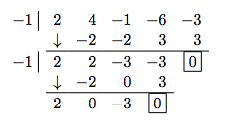
Success! Our quotient polynomial is now 2x2−3. Setting this to zero gives 2x2−3=0, or x2=32, which gives us x=±√62. Concerning multiplicities, based on our division, we have that −1 has a multiplicity of at least 2. The Factor Theorem tells us our remaining zeros, ±√62, each have multiplicity at least 1. However, Theorem 3.7 tells us f can have at most 4 real zeros, counting multiplicity, and so we conclude that −1 is of multiplicity exactly 2 and ±√62 each has multiplicity 1. (Thus, we were \underline{wrong} to think that −1 had multiplicity 3.)
It is interesting to note that we could greatly improve on the graph of y=f(x) in the previous example given to us by the calculator. For instance, from our determination of the zeros of f and their multiplicities, we know the graph crosses at x=−√62≈−1.22 then turns back upwards to touch the x−$axisat\(x=−1. This tells us that, despite what the calculator showed us the first time, there is a relative maximum occurring at x=−1 and not a 'flattened crossing' as we originally believed. After resizing the window, we see not only the relative maximum but also a relative minimum just to the left of x=−1 which shows us, once again, that Mathematics enhances the technology, instead of vice-versa. This is an example of what is called 'hidden behavior'.
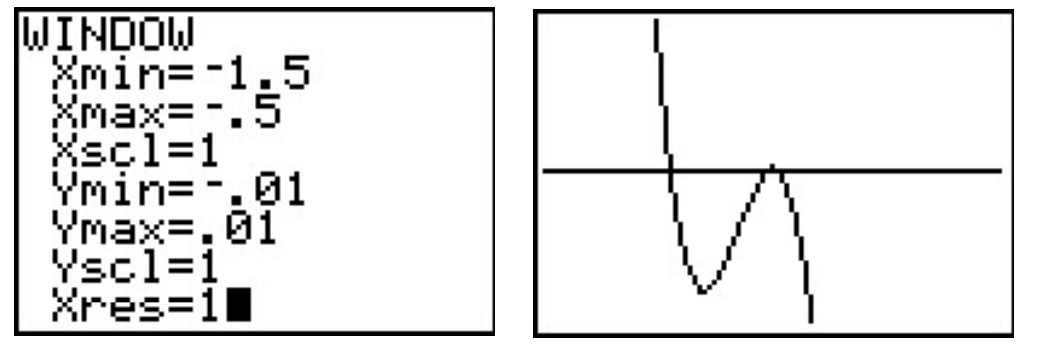
Our next example shows how even a mild-mannered polynomial can cause problems.
Example 3.3.4:
Let f(x)=x4+x2−12.
- Use Cauchy's Bound to determine an interval in which all of the real zeros of f lie.
- Use the Rational Zeros Theorem to determine a list of possible rational zeros of f.
- Graph y=f(x) using your graphing calculator.
- Find all of the real zeros of f and their multiplicities.
Solution
1. Applying Cauchy's Bound, we find M=12, so all of the real zeros lie in the interval [−13,13].
2. Applying the Rational Zeros Theorem with constant term a0=−12 and leading coefficient a4=1, we get the list {±1, ±2, ±3, ±4, ±6, ±12}.
3. Graphing y=f(x) on the interval [−13,13] produces the graph below on the left. Zooming in a bit gives the graph below on the right. Based on the graph, none of our rational zeros will work. (Do you see why not?)
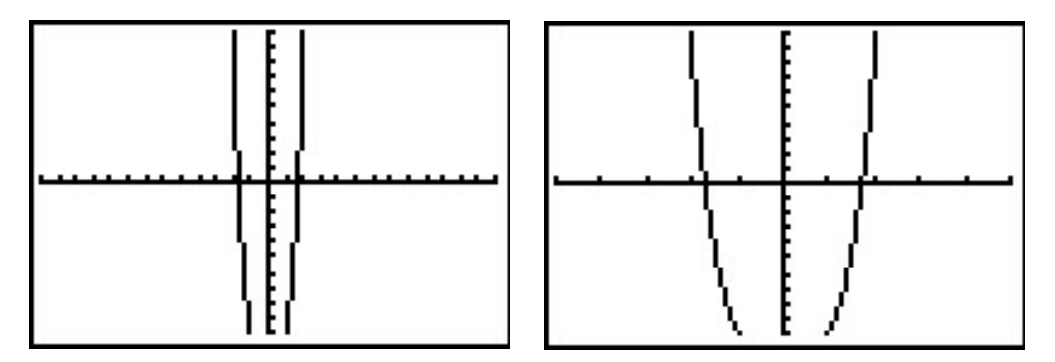
4. From the graph, we know f has two real zeros, one positive, and one negative. Our only hope at this point is to try and find the zeros of f by setting f(x)=x4+x2−12=0 and solving. If we stare at this equation long enough, we may recognize it as a 'quadratic in disguise' or 'quadratic in form'. In other words, we have three terms: x4, x2 and 12, and the exponent on the first term, x4, is exactly twice that of the second term, x2. We may rewrite this as (x2)2+(x2)−12=0. To better see the forest for the trees, we momentarily replace x2 with the variable u. In terms of u, our equation becomes u2+u−12=0, which we can readily factor as (u+4)(u−3)=0. In terms of x, this means x4+x2−12=(x2−3)(x2+4)=0. We get x2=3, which gives us x=±√3, or x2=−4, which admits no real solutions. Since √3≈1.73, the two zeros match what we expected from the graph. In terms of multiplicity, the Factor Theorem guarantees (x−√3) and (x+√3) are factors of f(x). Since f(x) can be factored as f(x)=(x2−3)(x2+4), and x2+4 has no real zeros, the quantities (x−√3) and (x+√3) must both be factors of x2−3. According to Theorem 3.7, x2−3 can have at most 2 zeros, counting multiplicity, hence each of ±√3 is a zero of f of multiplicity 1.
The technique used to factor f(x) in Example 3.3.4 is called u -substitution. We shall see more of this technique in Section 5.3. In general, substitution can help us identify a 'quadratic in disguise' provided that there are exactly three terms and the exponent of the first term is exactly twice that of the second. It is entirely possible that a polynomial has no real roots at all, or worse, it has real roots but none of the techniques discussed in this section can help us find them exactly. In the latter case, we are forced to approximate, which in this subsection means we use the 'Zero' command on the graphing calculator.
For Those Wishing NOT to use a Graphing Calculator
Suppose we wish to find the zeros of f(x)=2x4+4x3−x2−6x−3 without using the calculator. In this subsection, we present some more advanced mathematical tools (theorems) to help us. Our first result is due to Rene Descartes.
Theorem 3.10: Descartes' Rule of Signs
Suppose f(x) is the formula for a polynomial function written with descending powers of x.
- If P denotes the number of variations of sign in the formula for f(x), then the number of positive real zeros (counting multiplicity) is one of the numbers P,P−2,P−4,….
- If N denotes the number of variations of sign in the formula for f(−x), then the number of negative real zeros (counting multiplicity) is one of the numbers \{N\), N−2, N−4, \dots\}.
A few remarks are in order. First, to use Descartes' Rule of Signs, we need to understand what is meant by a variation in sign of a polynomial function. Consider f(x)=2x4+4x3−x2−6x−3. If we focus on only the signs of the coefficients, we start with a (+), followed by another (+), then switch to (−), and stay (−) for the remaining two coefficients. Since the signs of the coefficients switched once as we read from left to right, we say that f(x) has one variation in sign. When we speak of the variations in sign of a polynomial function f we assume the formula for f(x) is written with descending powers of x, as in Definition 3.1, and concern ourselves only with the nonzero coefficients. Second, unlike the Rational Zeros Theorem, Descartes' Rule of Signs gives us an estimate to the number of positive and negative real zeros, not the actual value of the zeros. Lastly, Descartes' Rule of Signs counts multiplicities. This means that, for example, if one of the zeros has multiplicity 2, Descsartes' Rule of Signs would count this as two zeros. Lastly, note that the number of positive or negative real zeros always starts with the number of sign changes and decreases by an even number. For example, if f(x) has 7 sign changes, then, counting multplicities, f has either 7, 5, 3 or 1 positive real zero. This implies that the graph of y=f(x) crosses the positive x-axis at least once. If f(−x) results in 4 sign changes, then, counting multiplicities, f has 4, 2 or 0 negative real zeros; hence, the graph of y=f(x) may not cross the negative x-axis at all.
Example 3.3.5:
Let f(x)=2x4+4x3−x2−6x−3. Use Descartes' Rule of Signs to determine the possible number and location of the real zeros of f.
Solution
As noted above, the variations of sign of f(x) is 1. This means, counting multiplicities, f has exactly 1 positive real zero. Since
f(−x)=2(−x)4+4(−x)3−(−x)2−6(−x)−3=2x4−4x3−x2+6x−3
has 3 variations in sign, f has either 3 negative real zeros or 1 negative real zero, counting multiplicities.
Cauchy's Bound gives us a general bound on the zeros of a polynomial function. Our next result helps us determine bounds on the real zeros of a polynomial as we synthetically divide which are often sharper\footnote{That is, better, or more accurate.} bounds than Cauchy's Bound.
Theorem 3.1.1: Upper and Lower Bounds
Suppose f is a polynomial of degree n≥1.
- If c>0 is synthetically divided into f and all of the numbers in the final line of the division tableau have the same signs, then c is an upper bound for the real zeros of f. That is, there are no real zeros greater than c.
- If c<0 is synthetically divided into f and the numbers in the final line of the division tableau alternate signs, then c is a lower bound for the real zeros of f. That is, there are no real zeros less than c.
If the number 0 occurs in the final line of the division tableau in either of the above cases, it can be treated as (+) or (−) as needed.
The Upper and Lower Bounds Theorem works because of Theorem 3.4. For the upper bound part of the theorem, suppose c>0 is divided into f and the resulting line in the division tableau contains, for example, all nonnegative numbers. This means f(x)=(x−c)q(x)+r, where the coefficients of the quotient polynomial and the remainder are nonnegative. (Note that the leading coefficient of q is the same as f so q(x) is not the zero polynomial.) If b>c, then f(b)=(b−c)q(b)+r, where (b−c) and q(b) are both positive and r≥0. Hence f(b)>0 which shows b cannot be a zero of f. Thus no real number b>c can be a zero of f, as required. A similar argument proves f(b)<0 if all of the numbers in the final line of the synthetic division tableau are non-positive. To prove the lower bound part of the theorem, we note that a lower bound for the negative real zeros of f(x) is an upper bound for the positive real zeros of f(−x). Applying the upper bound portion to f(−x) gives the result. (Do you see where the alternating signs come in?) With the additional mathematical machinery of Descartes' Rule of Signs and the Upper and Lower Bounds Theorem, we can find the real zeros of f(x)=2x4+4x3−x2−6x−3 without the use of a graphing calculator.
Example 3.3.6:
Let f(x)=2x4+4x3−x2−6x−3.
- Find all of the real zeros of f and their multiplicities.
- Sketch the graph of y=f(x).
Solution
1. We know from Cauchy's Bound that all of the real zeros lie in the interval [−4,4] and that our possible rational zeros are ±12, ±1, ±32 and ±3. Descartes' Rule of Signs guarantees us at least one negative real zero and exactly one positive real zero, counting multiplicity. We try our positive rational zeros, starting with the smallest, 12. Since the remainder isn't zero, we know 12 isn't a zero. Sadly, the final line in the division tableau has both positive and negative numbers, so 12 is not an upper bound. The only information we get from this division is courtesy of the Remainder Theorem which tells us f(12)=−458 so the point (12,−458) is on the graph of f. We continue to our next possible zero, 1. As before, the only information we can glean from this is that (1,−4) is on the graph of f. When we try our next possible zero, 32, we get that it is not a zero, and we also see that it is an upper bound on the zeros of f, since all of the numbers in the final line of the division tableau are positive. This means there is no point trying our last possible rational zero, 3. Descartes' Rule of Signs guaranteed us a positive real zero, and at this point we have shown this zero is irrational. Furthermore, the Intermediate Value Theorem, Theorem 3.1, tells us the zero lies between 1 and 32, since f(1)<0 and f(32)>0.

2. We now turn our attention to negative real zeros. We try the largest possible zero, −12. Synthetic division shows us it is not a zero, nor is it a lower bound (since the numbers in the final line of the division tableau do not alternate), so we proceed to −1. This division shows −1 is a zero. Descartes' Rule of Signs told us that we may have up to three negative real zeros, counting multiplicity, so we try −1 again, and it works once more. At this point, we have taken f, a fourth degree polynomial, and performed two successful divisions. Our quotient polynomial is quadratic, so we look at it to find the remaining zeros.

Setting the quotient polynomial equal to zero yields 2x2−3=0, so that x2=32, or x=±√62. Descartes' Rule of Signs tells us that the positive real zero we found, √62, has multiplicity 1. Descartes also tells us the total multiplicity of negative real zeros is 3, which forces −1 to be a zero of multiplicity 2 and −√62 to have multiplicity 1.
We know the end behavior of y=f(x) resembles that of its leading term y=2x4. This means that the graph enters the scene in Quadrant II and exits in Quadrant I. Since ±√62 are zeros of odd multiplicity, we have that the graph crosses through the x-axis at the points (−√62,0) and (√62,0). Since −1 is a zero of multiplicity 2, the graph of y=f(x) touches and rebounds off the x-axis at (−1,0). Putting this together, we get
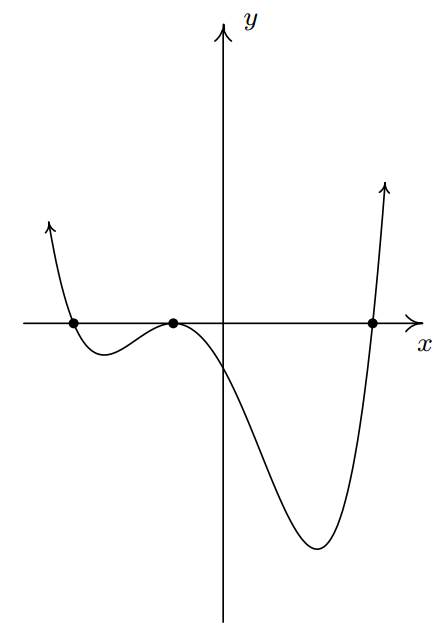
You can see why the 'no calculator' approach is not very popular these days. It requires more computation and more theorems than the alternative (this is apparently a bad thing). In general, no matter how many theorems you throw at a polynomial, it may well be impossible to find their zeros exactly (it can be proven that the zeros of some polynomials cannot be expressed using the usual algebraic symbols). The polynomial f(x)=x5−x−1 is one such beast.
According to Descartes' Rule of Signs, f has exactly one positive real zero, and it could have two negative real zeros, or none at all. The Rational Zeros Test gives us ±1 as rational zeros to try but neither of these work since f(1)=f(−1)=−1. If we try the substitution technique we used in Example 3.3.4, we find f(x) has three terms, but the exponent on the x5 isn't exactly twice the exponent on x. How could we go about approximating the positive zero without resorting to the 'Zero' command of a graphing calculator? We use the Bisection Method. The first step in the Bisection Method is to find an interval on which f changes sign. We know f(1)=−1 and we find f(2)=29. By the Intermediate Value Theorem, we know that the zero of f lies in the interval [1,2]. Next, we 'bisect' this interval and find the midpoint is 1.5. We have that f(1.5)≈5.09. This means that our zero is between 1 and 1.5, since f changes sign on this interval. Now, we 'bisect' the interval [1,1.5] and find f(1.25)≈0.80, so now we have the zero between 1 and 1.25. Bisecting [1,1.25], we find f(1.125)≈−0.32, which means the zero of f is between 1.125 and 1.25. We continue in this fashion until we have 'sandwiched' the zero between two numbers which differ by no more than a desired accuracy. You can think of the Bisection Method as reversing the sign diagram process: instead of finding the zeros and checking the sign of f using test values, we are using test values to determine where the signs switch to find the zeros. It is a slow and tedious, yet fool-proof, method for approximating a real zero.
Our next example reminds us of the role finding zeros plays in solving equations and inequalities.
Example 3.3.7:
- Find all of the real solutions to the equation 2x5+6x3+3=3x4+8x2.
- Solve the inequality 2x5+6x3+3≤3x4+8x2.
- Interpret your answer to part 2 graphically, and verify using a graphing calculator.
Solution
1. Finding the real solutions to 2x5+6x3+3=3x4+8x2 is the same as finding the real solutions to 2x5−3x4+6x3−8x2+3=0. In other words, we are looking for the real zeros of p(x)=2x5−3x4+6x3−8x2+3. Using the techniques developed in this section, we get
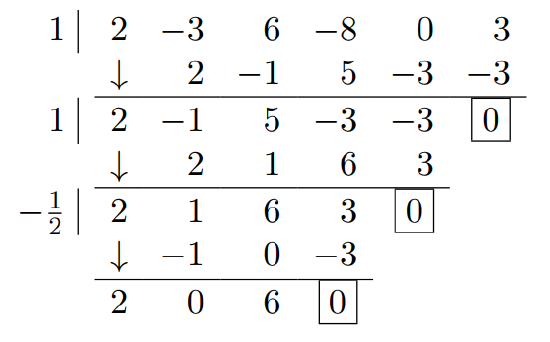
The quotient polynomial is 2x2+6 which has no real zeros so we get x=−12 and x=1.
2. To solve this nonlinear inequality, we follow the same guidelines set forth in Section 2.4: we get 0 on one side of the inequality and construct a sign diagram. Our original inequality can be rewritten as 2x5−3x4+6x3−8x2+3≤0. We found the zeros of p(x)=2x5−3x4+6x3−8x2+3 in part 1 to be x=−12 and x=1. We construct our sign diagram as before.
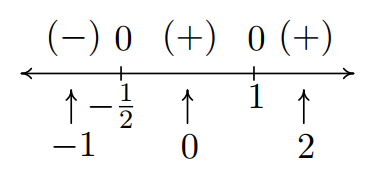
The solution to p(x)<0 is (−∞,−12), and we know p(x)=0 at x=−12 and x=1. Hence, the solution to p(x)≤0 is (−∞,−12]∪{1}.
3. To interpret this solution graphically, we set f(x)=2x5+6x3+3 and g(x)=3x4+8x2. We recall that the solution to f(x)≤g(x) is the set of x values for which the graph of f is below the graph of g (where f(x)<g(x) along with the x values where the two graphs intersect f(x)=g(x). Graphing f and g on the calculator produces the picture on the lower left. (The end behavior should tell you which is which.) We see that the graph of f is below the graph of g on (−∞,−12). However, it is difficult to see what is happening near x=1. Zooming in (and making the graph of g thicker), we see that the graphs of f and g do intersect at x=1, but the graph of g remains below the graph of f on either side of x=1.
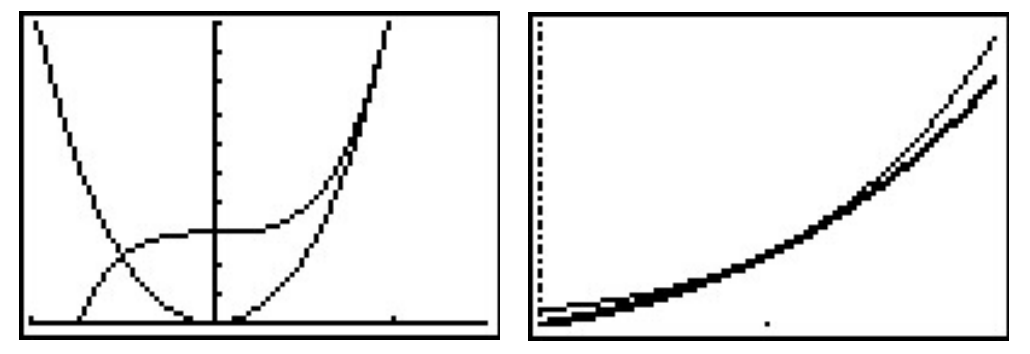
Our last example revisits an application in the Exercises of Section 3.1.
Example 3.3.8:
Suppose the profit P, in thousands of dollars, from producing and selling x hundred LCD TVs is given by P(x)=−5x3+35x2−45x−25, 0≤x≤10.07. How many TVs should be produced to make a profit? Check your answer using a graphing utility.
Solution
To 'make a profit' means to solve P(x)=−5x3+35x2−45x−25>0, which we do analytically using a sign diagram. To simplify things, we first factor out the −5 common to all the coefficients to get
−5(x3−7x2+9x−5)>0
so we can just focus on finding the zeros of f(x)=x3−7x2+9x+5. The possible rational zeros of f are ±1 and ±5, and going through the usual computations, we find x=5 is the only rational zero. Using this, we factor f(x)=x3−7x2+9x+5=(x−5)(x2−2x−1), and we find the remaining zeros by applying the Quadratic Formula to x2−2x−1=0. We find three real zeros, x=1−√2=−0.414…, x=1+√2=2.414…, and x=5, of which only the last two fall in the applied domain of [0,10.07]. We choose x=0, x=3 and x=10.07 as our test values and plug them into the function P(x)=−5x3+35x2−45x−25 (not f(x)=x3−7x2+9x−5) to get the sign diagram below.

We see immediately that P(x)>0 on (1+√2,5). Since x measures the number of TVs in hundreds, x=1+√2 corresponds to 241.4… TVs. Since we can't produce a fractional part of a TV, we need to choose between producing 241 and 242 TVs. From the sign diagram, we see that P(2.41)<0 but P(2.42)>0 so, in this case we take the next larger integer value and set the minimum production to 242 TVs. At the other end of the interval, we have x=5 which corresponds to 500 TVs. Here, we take the next smaller integer value, 499 TVs to ensure that we make a profit. Hence, in order to make a profit, at least 242, but no more than 499 TVs need to be produced. To check our answer using a calculator, we graph y=P(x) and make use of the 'Zero' command. We see that the calculator approximations bear out our analysis.
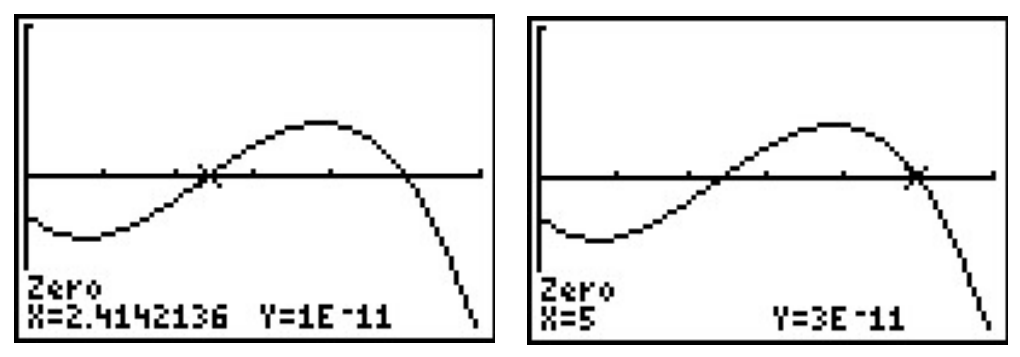
Note that the y-coordinates of the points here aren't registered as 0. They are expressed in Scientific Notation. For instance, 1E−11 corresponds to 0.00000000001, which is pretty close in the calculator's eyes to 0 (but not a Mathematician's).

